YAMAHA YFM40FBB, YFM40FBHB User Manual

 READ THIS MANUAL CAREFULLY!
READ THIS MANUAL CAREFULLY!
It contains important safety information.
OWNER’S MANUAL
YFM40FBB
YFM40FBHB
WARNING |
This ATV should not be ridden by anyone under 16 years of age. |
LIT-11626-25-02 |
4S1-F8199-15 |
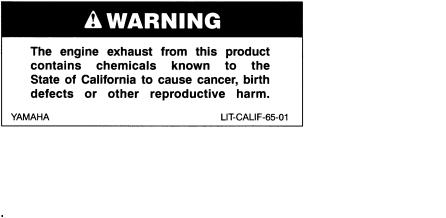
EBU17092
 Read this manual carefully before operating this vehicle. This manual should stay with this vehicle if it is sold.
Read this manual carefully before operating this vehicle. This manual should stay with this vehicle if it is sold.
EBU17170
INTRODUCTION
EBU17272
Congratulations on your purchase of the Yamaha YFM40FBB/YFM40FBHB. This ATV represents the result of many years of Yamaha experience in the production of fine sporting, touring, and pace-setting racing machines. With the purchase of this Yamaha, you can now appreciate the high degree of craftsmanship and reliability that have made Yamaha a leader in these fields.
This manual will provide you with a good basic understanding of the features and operation of this ATV.
This manual includes important safety information. It provides information about special techniques and skills necessary to ride the ATV. It also includes basic maintenance and inspection procedures. If you have any questions regarding the operation or maintenance of your ATV, please consult a Yamaha dealer.
AN IMPORTANT SAFETY MESSAGE:
●Read this manual together with TIPS FOR THE ATV RIDER carefully and completely before operating your ATV. Make sure you understand all instructions.
●Pay close attention to the warning and notice labels on the ATV.
●Never operate an ATV without proper training or instruction. Free training is available to anyone who buys a new ATV. Call 1-800-887-2887 for more information.
●This ATV should not be ridden by anyone under 16 years of age.

EBU17330
IMPORTANT MANUAL INFORMATION
EBU17342
FAILURE TO FOLLOW THE WARNINGS CONTAINED IN THIS MANUAL CAN RESULT IN SERIOUS INJURY OR DEATH.
Particularly important information is distinguished in this manual by the following notations:
|
|
|
|
This is the safety alert symbol. It is used to alert you to potential per- |
|
|
|
|
sonal injury hazards. Obey all safety messages that follow this sym- |
|
|
|
|
bol to avoid possible injury or death. |
|
|
|
|
|
|
|
|
|
|
|
|
|
|
A WARNING indicates a hazardous situation which, if not avoided, |
|
WARNING |
|
||
|
|
could result in death or serious injury. |
||
|
|
|
|
|
|
|
|
|
|
|
|
|
|
|
|
|
|
|
A NOTICE indicates special precautions that must be taken to avoid |
|
NOTICE |
|
|
|
|
|
damage to the vehicle or other property. |
||
|
|
|
|
|
|
|
|
|
|
TIP |
A TIP provides key information to make procedures easier or clearer. |
|
|
* Product and specifications are subject to change without notice.

EBU17350
IMPORTANT NOTICE
EBU17362
This ATV is designed and manufactured for off-road use only. It is illegal and unsafe to operate this ATV on any public street, road or highway.
This ATV complies with all applicable off-road noise level and spark arrester laws and regulations in effect at the time of manufacture.
Please check your local riding laws and regulations before operating this ATV.
EBU17402
YFM40FBB/YFM40FBHB
OWNER’S MANUAL
©2011 by Yamaha Motor Corporation, U.S.A. 1st edition, February 2011
All rights reserved.
Any reprinting or unauthorized use without the written permission of Yamaha Motor Corporation, U.S.A. is expressly prohibited.
Printed in U.S.A.
P/N LIT-11626-25-02

EWB00011
 WARNING
WARNING
Indicates a hazardous situation which, if not avoided, could result in death or serious injury.
EBU17420
TABLE OF CONTENTS
LOCATION OF THE WARNING AND |
|
SPECIFICATION LABELS ............................ |
1-1 |
SAFETY INFORMATION .............................. |
2-1 |
DESCRIPTION .............................................. |
3-1 |
Left view ...................................................... |
3-1 |
Right view.................................................... |
3-1 |
Controls and instruments ............................ |
3-2 |
INSTRUMENT AND CONTROL |
|
FUNCTIONS .................................................. |
4-1 |
Main switch ................................................ |
4-1 |
Indicator lights and warning light ................ |
4-2 |
Speedometer .............................................. |
4-3 |
Fuel gauge ................................................. |
4-4 |
Handlebar switches .................................... |
4-5 |
Throttle lever ............................................. |
4-10 |
Speed limiter ............................................. |
4-11 |
Front brake lever ....................................... |
4-11 |
Brake pedal and rear brake lever ............. |
4-12 |
Parking brake ............................................ |
4-13 |
Shift pedal ................................................. |
4-13 |
Reverse knob “REV” ................................. |
4-14 |
Recoil starter ............................................. |
4-14 |
Fuel tank cap ............................................ |
4-15 |
Fuel ........................................................... |
4-15 |
Fuel cock .................................................. |
4-17 |
Starter (choke) .......................................... |
4-18 |
Seat .......................................................... |
4-19 |
Storage compartment ............................... |
4-20 |
Front carrier .............................................. |
4-20 |
Rear carrier ............................................... |
4-21 |
Auxiliary DC jack ....................................... |
4-21 |
PRE-OPERATION CHECKS .......................... |
5-1 |
Fuel ............................................................. |
5-3 |
Engine oil .................................................... |
5-3 |
Final gear oil ............................................... |
5-3 |
Differential gear oil ...................................... |
5-3 |
Front and rear brakes ................................. |
5-3 |
Throttle lever ............................................... |
5-4 |
Tires ............................................................ |
5-4 |
Chassis fasteners ....................................... |
5-6 |
Instruments, lights and switches ................ |
5-6 |
OPERATION .................................................. |
6-1 |
Starting a cold engine ................................ |
6-1 |
Starting a warm engine .............................. |
6-3 |
Shifting ....................................................... |
6-3 |
Operating the reverse knob and driving in |
|
reverse ..................................................... |
6-4 |
Engine break-in .......................................... |
6-5 |
Parking ....................................................... |
6-6 |
Parking on a slope ..................................... |
6-7 |
Accessories and loading ............................ |
6-7 |
RIDING YOUR ATV ...................................... |
7-1 |
GETTING TO KNOW YOUR ATV............... |
7-2 |
RIDE WITH CARE AND GOOD |
|
JUDGMENT .............................................. |
7-2 |
BE CAREFUL WHERE YOU RIDE............. |
7-9 |
TURNING YOUR ATV .............................. |
7-12 |
CLIMBING UPHILL ................................... |
7-14 |
RIDING DOWNHILL.................................. |
7-17 |
CROSSING A SLOPE............................... |
7-18 |
CROSSING THROUGH SHALLOW |
|
WATER ................................................... |
7-19 |
RIDING OVER ROUGH TERRAIN ........... |
7-20 |
SLIDING AND SKIDDING......................... |
7-21 |
WHAT TO DO IF... .................................... |
7-22 |
WHAT TO DO............................................ |
7-22 |
PERIODIC MAINTENANCE AND |
|
ADJUSTMENT................................................ |
8-1 |
Owner’s manual and tool kit ....................... |
8-2 |
Periodic maintenance chart for the |
|
emission control system ........................... |
8-3 |
General maintenance and lubrication |
|
chart .......................................................... |
8-5 |
Checking the spark plug ............................. |
8-9 |
Engine oil and oil filter element ................. |
8-11 |
Final gear oil ............................................. |
8-15 |
Differential gear oil .................................... |
8-18 |
Cleaning the air filter element ................... |
8-20 |
Cleaning the spark arrester ...................... |
8-24 |
Adjusting the carburetor ............................ |
8-25 |
Adjusting the engine idling speed ............. |
8-26 |
Adjusting the throttle lever free play ......... |
8-27 |
Valve clearance ........................................ |
8-27 |
Adjusting the reverse lock release |
|
cable ....................................................... |
8-28 |
Brakes ....................................................... |
8-28 |
Checking the front brake pads and |
|
rear brake friction plates ......................... |
8-28 |
Checking the brake fluid level ................... |
8-29 |
Changing the brake fluid ........................... |
8-31 |
Checking the front brake lever free |
|
play ......................................................... |
8-31 |
Adjusting the brake pedal and rear brake |
|
lever free play ......................................... |
8-31 |
Axle boots ................................................ |
8-35 |
Brake light switches ................................. |
8-36 |
Adjusting the clutch free play ................... |
8-36 |
Checking and lubricating the cables ........ |
8-37 |
Checking and lubricating the front and |
|
rear brake levers .................................... |
8-38 |
Checking and lubricating the brake and |
|
shift pedals ............................................. |
8-39 |
Checking the wheel hub bearings ............ |
8-40 |
Lubricating the drive shaft universal |
|
joint ......................................................... |
8-40 |
Checking the stabilizer bushes ................ |
8-40 |
Lubricating the rear knuckle pivots ........... |
8-40 |
Lubricating the steering shaft ................... |
8-41 |
Battery ...................................................... |
8-41 |
Replacing a fuse ...................................... |
8-44 |
Replacing a headlight bulb ....................... |
8-45 |
Adjusting a headlight beam ...................... |
8-48 |
Replacing the tail/brake light bulb ............ |
8-48 |
Removing a wheel .................................... |
8-50 |
Installing a wheel ...................................... |
8-50 |
Troubleshooting ....................................... |
8-52 |
Troubleshooting chart .............................. |
8-53 |
CLEANING AND STORAGE .......................... |
9-1 |
Cleaning ...................................................... |
9-1 |
Storage ....................................................... |
9-2 |
SPECIFICATIONS ....................................... |
10-1 |
CONSUMER INFORMATION....................... |
11-1 |
Identification numbers ............................... |
11-1 |
Noise regulation ........................................ |
11-4 |
Maintenance record .................................. |
11-5 |
YAMAHA MOTOR CORPORATION, |
|
U.S.A. ATV LIMITED WARRANTY ......... |
11-6 |
YAMAHA EXTENDED SERVICE |
|
(Y.E.S.) ................................................... |
11-8 |

EBU17660
LOCATION OF THE WARNING AND SPECIFICATION LABELS
1
1 |
2 |
3 |
4 |
5 |
6 |
7 |
8 |
9 |
10 |
1-1

EBU17670
1Read and understand all of the labels on your ATV. These labels contain important information for safe and proper operation.
Never remove any labels from your ATV. If a label becomes difficult to read or comes off, request a replacement label from your Yamaha dealer.
1 |
2 |
5ND-F4877-30 |
3.6 psi, (25 kPa) |
|
3.6 psi, (25 kPa) |
|
3.2 psi, (22 kPa) |
3 |
3.2 psi, (22 kPa) |
|
: 176 lbs (80 kg) |
|
463 lbs, (210 kg) |
5ND-F4897-30
5FU-F816M-00
1-2
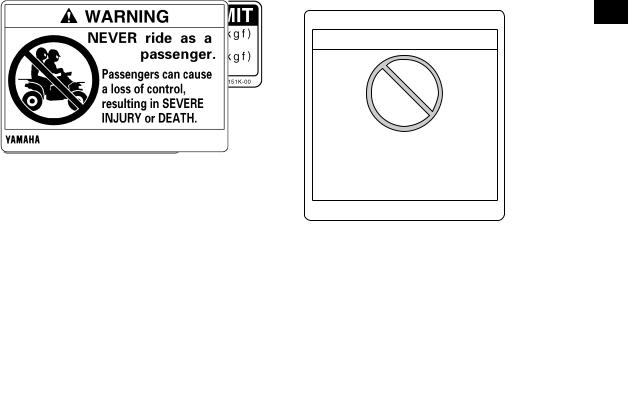
4 |
6 |
5
1
 WARNING
WARNING
UNDER
16
Operating this ATV if you are under the age of 16 increases your chance of severe injury or death.
NEVER operate this ATV if you are under age 16.
1P0-F816L-00
7
1-3
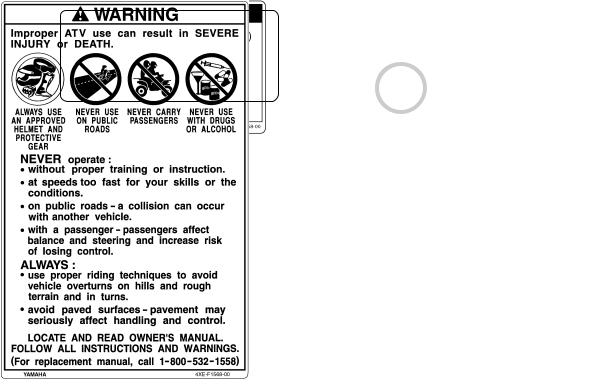
8 |
10 |
1
Certification of Compliance
This ATV complies with applicable provisions of ANSI/SVIA 1-2010 and is subject to an approved ATV action plan submitted by YAMAHA and on file with the U.S. Consumer Product safety Commission. YAMAHA MOTOR CORPORATION U.S.A.
6555 Katella Avenue, Cypress, California 90630-5101, U.S.A.
37S-F817J-30
9
1-4

EBU17431
 SAFETY INFORMATION
SAFETY INFORMATION
EBU17446
AN ATV IS NOT A TOY AND CAN BE HAZARDOUS TO OPERATE.
An ATV handles differently from other vehicles, including motorcycles and cars. A collision or rollover can occur quickly, even during routine maneuvers such as turning and riding on hills or over obstacles, if you fail to take proper precautions.
SEVERE INJURY OR DEATH can result if you do not follow these instructions:
●Read this manual and all labels carefully and follow the operating procedures described.
●Never operate an ATV without proper training or instruction. Take a Training Course. Beginners should receive training from a certified instructor. Contact an authorized ATV dealer or call 1- 800-887-2887 to find out about the training courses nearest you.
●Always follow the age recommendation:
– A child under 16 years old should never operate an ATV with engine size greater than 90 cc.
2-1
● Never allow a child under age 16 to operate an 2 ATV without adult supervision, and never allow continued use of an ATV by a child if he or she does not have the abilities to operate it safely.
●Never carry a passenger on an ATV.
●Always avoid operating an ATV on any paved surfaces, including sidewalks, driveways, parking lots and streets.
●Never operate an ATV on any public street, road or highway, even a dirt or gravel one.
●Never operate an ATV without wearing an approved motorcycle helmet that fits properly. You should also wear eye protection (goggles or face shield), gloves, boots, a long-sleeved shirt or a jacket, and long pants.
●Never consume alcohol or drugs before or while operating this ATV.
●Never operate at speeds too fast for your skills or the riding conditions. Always go at a speed that is proper for the terrain, visibility, operating conditions, and your experience.
●Never attempt wheelies, jumps, or other stunts.

● Always inspect your ATV each time you use it to make sure it is in safe operating condition. Always follow the inspection and maintenance procedures and schedules described in this
2manual.
●Always keep both hands on the handlebars and both feet on the footboards of the ATV during operation.
●Always go slowly and be extra careful when operating on unfamiliar terrain. Always be alert to changing terrain conditions when operating the ATV.
●Never operate on excessively rough, slippery or loose terrain until you have learned and practiced the skills necessary to control the ATV on such terrain. Always be especially cautious on these kinds of terrain.
●Always follow proper procedures for turning as described in this manual. Practice turning at low speeds before attempting to turn at faster speeds and never turn at excessive speeds.
●Never operate the ATV on hills too steep for the ATV or for your abilities. Practice on smaller hills before attempting larger hills.
●Always follow proper procedures for climbing hills as described in this manual. Check the terrain carefully before you start up any hill. Never climb hills with excessively slippery or loose surfaces. Shift your weight forward. Never open the throttle suddenly or make sudden gear changes. Never go over the top of a hill at high speed.
●Always follow proper procedures for going down hills and for braking on hills as described in this manual. Check the terrain carefully before you start down any hill. Shift your weight backward. Never go down a hill at high speed. Avoid going down a hill at an angle that would cause the vehicle to lean sharply to one side. Go straight down the hill where possible.
●Always follow proper procedures for crossing the side of a hill as described in this manual. Avoid hills with excessively slippery or loose surfaces. Shift your weight to the uphill side of the ATV. Never attempt to turn the ATV around on any hill until you have mastered the turning technique described in this manual on level ground. Avoid crossing the side of a steep hill if possible.
●Always use proper procedures if you stall or roll backwards when climbing a hill. To avoid stalling, use the proper gear and maintain a steady
2-2

speed when climbing a hill. If you stall or roll backwards, follow the special procedure for braking described in this manual. Dismount on the uphill side or to a side if pointed straight uphill. Turn the ATV around and remount, following the procedure described in this manual.
●Always check for obstacles before operating in a new area.
●Never attempt to operate over large obstacles, such as large rocks or fallen trees. Always follow proper procedures when operating over obstacles as described in this manual.
●Always be careful when skidding or sliding. Learn to safely control skidding or sliding by practicing at low speeds and on level, smooth terrain. On extremely slippery surfaces, such as ice, go slowly and be very cautious in order to reduce the chance of skidding or sliding out of control.
●Never operate an ATV in fast flowing water or in water deeper than that recommended in this manual. Remember that wet brakes may have reduced stopping ability. Test your brakes after leaving water. If necessary, apply them several times to let friction dry out the linings.
●Always be sure there are no obstacles or people behind you when you operate in reverse. When it is safe to proceed in reverse, go slowly.
●Always use the size and type of tires specified in
this manual. |
2 |
|
●Always maintain proper tire pressure as described in this manual.
●Never modify an ATV through improper installation or use of accessories.
●Never exceed the stated load capacity for an ATV. Cargo should be properly distributed and securely attached. Reduce speed and follow instructions in this manual for carrying cargo or pulling a trailer. Allow greater distance for braking.
2-3

EWB00072
 WARNING
WARNING
Avoid Carbon Monoxide Poisoning
All engine exhaust contains carbon monoxide,
2a deadly gas. Breathing carbon monoxide can cause headaches, dizziness, drowsiness, nausea, confusion, and eventually death.
Carbon Monoxide is a colorless, odorless, tasteless gas which may be present even if you do not see or smell any engine exhaust. Deadly levels of carbon monoxide can collect rapidly and you can quickly be overcome and unable to save yourself. Also, deadly levels of carbon monoxide can linger for hours or days in enclosed or poorly ventilated areas. If you experience any symptoms of carbon monoxide poisoning, leave the area immediately, get fresh air, and SEEK MEDICAL TREATMENT.
●Do not run engine indoors. Even if you try to ventilate engine exhaust with fans or open windows and doors, carbon monoxide can rapidly reach dangerous levels.
●Do not run engine in poorly ventilated or partially enclosed areas such as barns, garages, or carports.
●Do not run engine outdoors where engine exhaust can be drawn into a building through openings such as windows and doors.
EWB02591
 WARNING
WARNING
When transporting the ATV in another vehicle, be sure it is kept upright and that the fuel cock is in the “OFF” position. Otherwise, fuel may leak out of the carburetor or fuel tank.
2-4

FOR MORE INFORMATION ABOUT ATV SAFETY, call the Consumer Products Safety Commission at 1-800-638-2772, or the ATV Distributor’s
Safety Hotline at 1-800-852-5344.
2
2-5

EBU17680
|
|
|
|
|
|
|
DESCRIPTION |
|
|
|
|
|
|
|||||
|
|
|
EBU17690 |
|
|
|
|
|
EBU17700 |
|
|
|
|
|
|
|||
|
|
|
Left view |
|
|
|
|
|
Right view |
|
|
|
|
|
|
|||
|
|
|
1 2 3 |
4 |
5 |
6 |
1 |
|
2 |
3 4 |
||||||||
|
3 |
|
||||||||||||||||
|
|
|
|
|
|
|
|
|
|
|
|
|
|
|
|
|
|
|
|
|
|
|
|
|
|
|
|
|
|
|
|
|
|
|
|
|
|
|
|
|
|
|
|
|
|
|
|
|
|
|
|
|
|
|
|
|
|
|
|
|
|
|
|
|
|
|
|
|
|
|
|
|
|
|
|
|
|
|
|
|
|
|
|
|
|
|
|
|
|
|
|
|
|
|
|
|
|
|
|
|
|
|
|
|
|
|
|
|
|
|
|
|
|
|
|
|
|
|
|
|
|
|
|
|
|
|
|
|
|
|
|
|
|
|
|
|
|
|
|
|
|
|
|
|
|
|
|
|
|
|
|
|
|
|
|
|
|
|
|
|
|
|
|
|
|
|
|
|
|
|
|
|
|
|
|
|
|
|
|
|
|
|
|
|
|
|
|
|
|
|
|
|
|
|
|
|
|
|
|
|
|
|
|
|
|
|
|
|
|
8 |
7 |
|
7 6 |
5 |
1. |
Fuel cock |
|
1. |
Spark arrester |
|
2. |
Recoil starter |
|
2. |
Air filter case |
|
3. |
Throttle stop screw |
|
3. |
Engine oil filler cap |
|
4. |
Fuses |
|
4. |
Spark plug |
|
5. |
Battery |
|
5. |
Oil filter element |
|
6. |
Storage compartment and tool kit |
6. |
Brake pedal |
|
|
7. |
Clutch adjusting screw |
|
7. |
Rear brake light switch |
|
8. |
Shift pedal |
|
|
|
|
3-1

EBU17712
Controls and instruments
1.Rear brake lever
2.Parking brake lock plate
3.Starter (choke)
4.Speedometer
5.Reverse knob
6.Auxiliary DC jack
7.Front brake fluid reservoir
8.On-Command four-wheel-drive/differential gear lock switch
9.Front brake lever
10.Throttle lever 11.Fuel gauge 12.Main switch 13.Handlebar switches
TIP
The ATV you have purchased may differ slightly from the figures shown in this manual.
3
3-2

EBU17725
INSTRUMENT AND CONTROL FUNCTIONS
EWB00011
 WARNING
WARNING
Indicates a hazardous situation which, if not avoided, could result in death or serious injury.
4 |
EBU17770 |
|
Main switch |
||
|
The positions of the main switch are as follows:
ON
All electrical systems are supplied with power. The headlights, meter lighting and taillight come on when the light switch is on, and the engine can be started. The key cannot be removed.
OFF
All electrical systems are off. The key can be removed.
1. Main switch
4-1

EBU17815
Indicator lights and warning light
1.Reverse indicator light “REVERSE”
2.Neutral indicator light “NEUTRAL”
3.Oil temperature warning light “
 ”
”
4.On-Command differential gear lock indicator light “  ”
”
5.On-Command four-wheel-drive indicator light “ 


 ”
”
EBU17870
Neutral indicator light “NEUTRAL”
This indicator light comes on when the transmission is in the neutral position.
EBU28331
Reverse indicator light “REVERSE”
This indicator light comes on when the transmission is in the reverse position.
Furthermore, this indicator light flashes:
●when the override switch is being pushed,
●when the engine is being raced for 10 seconds or more.
TIP
If the indicator light flashes under any other circumstances or the speedometer does not show the speed while riding, have a Yamaha dealer check 4 the speed sensor circuit.
EBU26932
Oil temperature warning light “
 ”
”
This warning light comes on when the engine overheats. When this occurs, stop the engine as soon as it is safe to do so, and allow it to cool.
The electrical circuit of the warning light can be checked by turning the key to “ON”, with the engine stop switch set to “  ”, and then pushing the start switch.
”, and then pushing the start switch.
If the warning light does not come on while the start switch is being pushed, or if the warning light remains on after the start switch is released, have a Yamaha dealer check the electrical circuit.
If the warning light stays on when the engine is cool, have a Yamaha dealer check the electrical circuit.
4-2

ECB00010
NOTICE
●The engine may overheat if the ATV is overloaded. In this case, reduce the load to specification.
●Start the engine after making sure that the warning light is out. Continuous use while
|
|
|
|
the warning light is on may cause damage to |
|
4 |
|
||
|
|
|
the engine. |
|
|
|
|
|
|
|
|
|
|
|
EBU29611
On-Command four-wheel-drive indicator light “ 


 ” and On-Command differential gear lock indicator light “
” and On-Command differential gear lock indicator light “  ”
”
The On-Command four-wheel-drive indicator light “ 


 ” comes on when the On-Command four- wheel-drive switch is set to the “4WD” position.
” comes on when the On-Command four- wheel-drive switch is set to the “4WD” position.
The On-Command differential gear lock indicator light “  ” and the On-Command four-wheel-drive indicator light “
” and the On-Command four-wheel-drive indicator light “ 


 ” come on when the On-Com- mand differential gear lock switch is set to the “LOCK” position.
” come on when the On-Com- mand differential gear lock switch is set to the “LOCK” position.
TIP
Due to the synchronizing mechanism in the differential gear case, the light may not come on until the ATV starts moving.
EBU18022
Speedometer
This speedometer is equipped with an odometer and a tripmeter. The tripmeter can be reset to zero with the reset knob. Use the tripmeter to estimate how far you can ride on a tank of fuel before going to reserve. This information will enable you to plan fuel stops in the future.
4-3
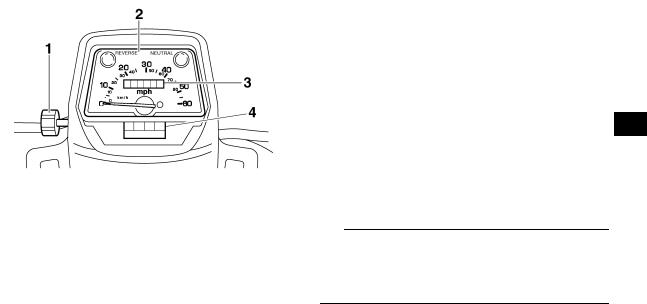
1.Reset knob
2.Speedometer
3.Odometer
4.Tripmeter
EBU18050
Fuel gauge
The fuel gauge indicates the amount of fuel in the fuel tank. When the needle reaches the red line, refill the tank at the first opportunity.
4
1.Fuel gauge
2.Red line
TIP
If the ATV runs out of fuel, move the fuel cock lever to the “RES” position. Approximately 4.0 L (1.06 US gal, 0.88 Imp.gal) of fuel will be remaining in the tank.
4-4
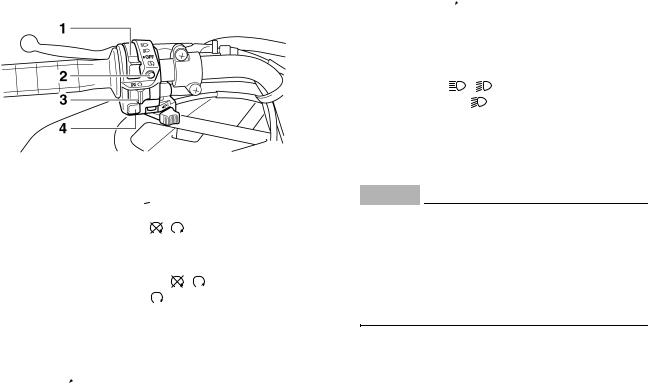
EBU18061
Handlebar switches
4
1.Light switch “  /
/  /OFF”
/OFF”
2.Start switch “  ”
”
3. |
Engine stop switch “ |
/ |
” |
4. |
Override switch “OVERRIDE” |
||
EBU18080 |
|
|
|
Engine stop switch “ |
/ ” |
||
Set this switch to “ |
” before starting the engine. |
||
The engine stop switch controls the ignition and stops the engine when it is running. Use this switch to stop the engine in an emergency situation. The engine will not start or run when this switch is set to “ ”.
”.
EBU18101
Start switch “ ”
”
Push this switch to crank the engine with the starter. See the starting instructions on page 6-1 prior to starting the engine.
EBU18162 |
|
|
Light switch “ |
/ |
/OFF” |
Set this switch to “ |
|
” to turn on the low beams, |
the taillight and the meter lighting. Set the switch to “  ” to turn on the high beams, the taillight and the meter lighting. Set the switch to “OFF” to turn off all the lights.
” to turn on the high beams, the taillight and the meter lighting. Set the switch to “OFF” to turn off all the lights.
ECB00042
NOTICE
Do not use the headlights with the engine turned off for an extended period of time, otherwise the battery may discharge to the point that the starter motor will not operate properly. If this should happen, remove the battery and recharge it. See page 8-43 for battery charging information.
4-5

EBU28510
Override switch “OVERRIDE”
1
1. Override switch “OVERRIDE”
Top speed is normally limited when operating in differential gear lock. If conditions require more engine power when riding forward, push and hold this switch to override the differential gear lock speed limiting function. (See page 4-8.) Releasing the switch restores the speed limiting function.
While the override switch is pushed, the reverse indicator light “REVERSE” will flash.
EWB00150
 WARNING
WARNING
Always ride at a slow speed when the ATV is in four-wheel-drive differential gear lock, and allow extra time and distance for maneuvers.
All wheels turn at the same speed when the differential is locked, so it takes more effort to turn the ATV. The effort needed to turn increas-
es with the riding speed. You may lose control 4 and have an accident if you cannot make a sharp enough turn for the speed you are traveling.
4-6

EBU28432
On-Command four-wheel-drive switch “2WD”/“4WD”
EWB00163
 WARNING
WARNING
Always stop the ATV before changing from two-wheel drive to four-wheel drive and vice versa. The ATV handles differently in two-
4wheel drive than in four-wheel drive in some circumstances. Changing from two-wheel drive to four-wheel drive or vice versa while moving may cause the ATV to unexpectedly handle differently. This could distract the operator and increase the risk of losing control and of causing an accident.
This ATV is equipped with a switch to change from two-wheel drive to four-wheel drive and vice versa. Select the appropriate drive according to the terrain and the conditions.
●“2WD” (two-wheel drive): Power is supplied to the rear wheels.
●“4WD” (four-wheel drive): Power is supplied to the rear and front wheels.
To change from two-wheel drive to four-wheel drive, stop the ATV and push the switch in to the “4WD” position. The four-wheel-drive indicator light “ 


 ” comes on.
” comes on.
To change from four-wheel drive to two-wheel drive, stop the ATV and push the switch in to the “2WD” position.
1. On-Command four-wheel-drive switch “2WD”/“4WD”
4-7

EBU28372
On-Command differential gear lock switch “4WD”/“LOCK”
EWB00131
 WARNING
WARNING
Always stop the ATV before changing from four-wheel drive to four-wheel-drive differential gear lock or vice versa.
The ATV handles differently in four-wheel drive than in differential gear lock in some circumstances. Changing from four-wheel drive to differential gear lock or vice versa while moving may cause the ATV to handle differently unexpectedly. This could distract the operator and increase the risk of losing control and causing an accident.
EWB00140
 WARNING
WARNING
Always ride at a slow speed when the ATV is in differential gear lock, and allow extra time and distance for maneuvers.
All wheels turn at the same speed when the differential gear is locked, so it takes more effort to turn the ATV. The effort needed to turn increases with the riding speed. You may lose
control and have an accident if you cannot make a sharp enough turn for the speed you are traveling.
This ATV is equipped with a switch allowing you to lock the differential gear when in four-wheel drive. Select the appropriate switch position according to the terrain and the conditions.
● “4WD” (four-wheel drive): Power is supplied to 4 the rear and front wheels.
●“LOCK” (four-wheel drive with the differential gear locked): Power is supplied to the rear and front wheels and the differential gear is locked. Unlike in four-wheel drive, all wheels turn at the same speed.
4-8

4
1.On-Command four-wheel-drive switch “2WD”/“4WD”
2.On-Command differential gear lock switch “4WD”/“LOCK”
To lock the differential gear in four-wheel drive, make sure the On-Command four-wheel-drive switch is pushed in to the “4WD” position.
1.Differential gear lock lever
2.On-Command four-wheel-drive switch “2WD”/“4WD”
Stop the ATV, move the differential gear lock lever to position (a), and then push the differential gear lock switch in to the “LOCK” position. When the differential gear is locked, the differential gear lock indicator light “  ” comes on.
” comes on.
4-9

1. On-Command differential gear lock switch “4WD”/“LOCK”
To release the differential gear lock, stop the ATV and push the switch to the “4WD” position.
TIP
●If the differential gear lock is not engaging properly, turn the handlebar back and forth to help it engage.
●Riding before the differential gear lock is properly engaged will cause the vehicle speed to be limited until engagement is complete.
●When the ATV is in four-wheel-drive differential gear lock, the maximum traveling speed is limited to 31 km/h (19 mi/h). However, if conditions require full engine power to be available, push
and hold the override switch to disable the differential gear lock speed limiter. (See page 4-6 for a detailed explanation of this switch.)
EBU18282
Throttle lever
Once the engine is running, pushing the throttle le-
ver will increase the engine speed.
4
Regulate the speed of the ATV by varying the throttle position. Because the throttle is springloaded, the ATV will decelerate, and the engine will return to an idle any time the throttle lever is released.
1. Throttle lever
4-10

Before starting the engine, check the throttle to be sure it is operating smoothly. Make sure it returns to the idle position as soon as the lever is released.
EBU18323
Speed limiter
Your ATV is equipped with an adjustable speed limiter. The speed limiter keeps the throttle from
4fully opening, even when the throttle lever is pushed to the maximum.
1.Loosen the locknut.
2.To increase the maximum engine power available and the maximum speed of the ATV, turn the adjusting screw in direction (a). To decrease the maximum engine power available and the maximum speed of the ATV, turn the adjusting screw in direction (b). Do not turn the adjusting screw out more than 12 mm (0.47 in) or the throttle cable could be damaged. Always make sure the throttle lever free play is adjusted to 3.0–5.0 mm (0.12–0.20 in). (See page 8-27.) WARNING! Improper adjustment of the speed limiter and throttle could cause throttle cable damage or improper throttle operation. You could lose control, resulting in an accident. [EWB00241]
1.Locknut
2.Adjusting screw
3.No more than 12 mm (0.47 in)
3.Tighten the locknut.
EBU18391
Front brake lever
The front brake lever is located on the right handlebar. To apply the front brake, pull the brake lever toward the handlebar grip.
4-11
